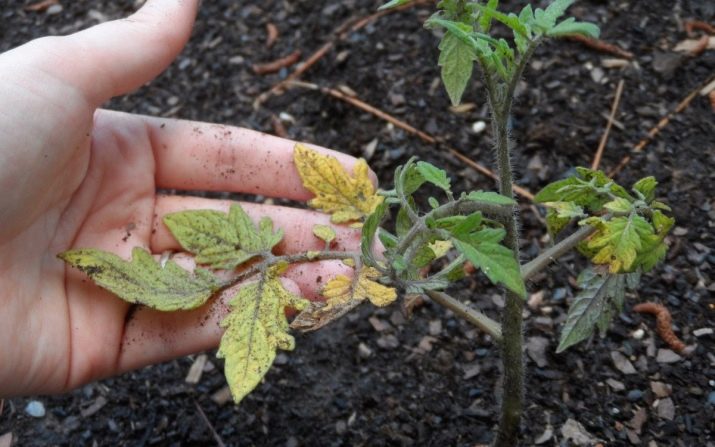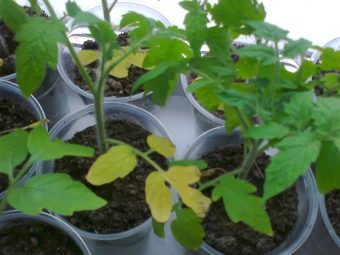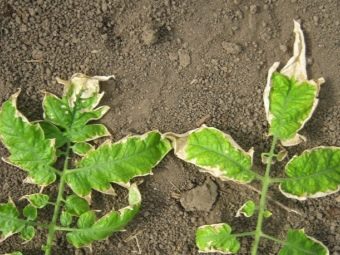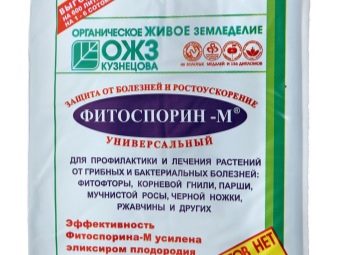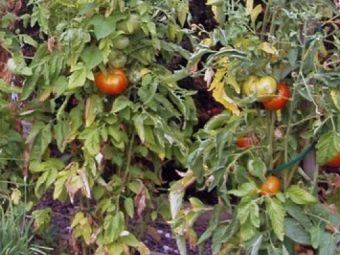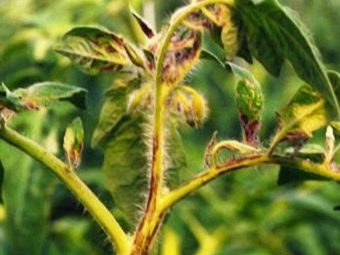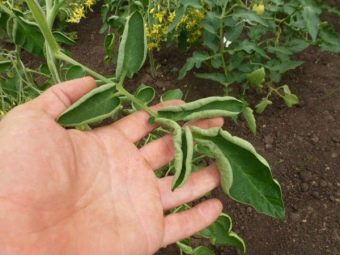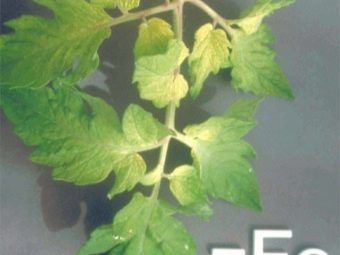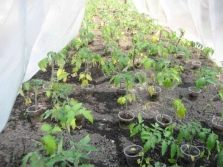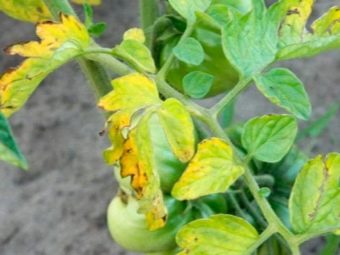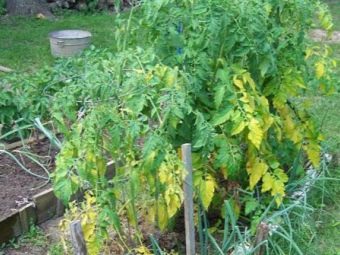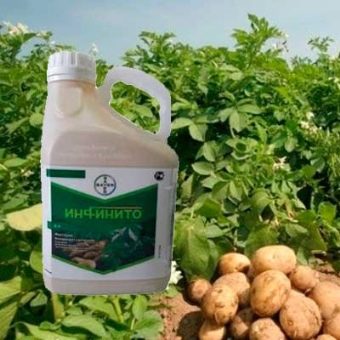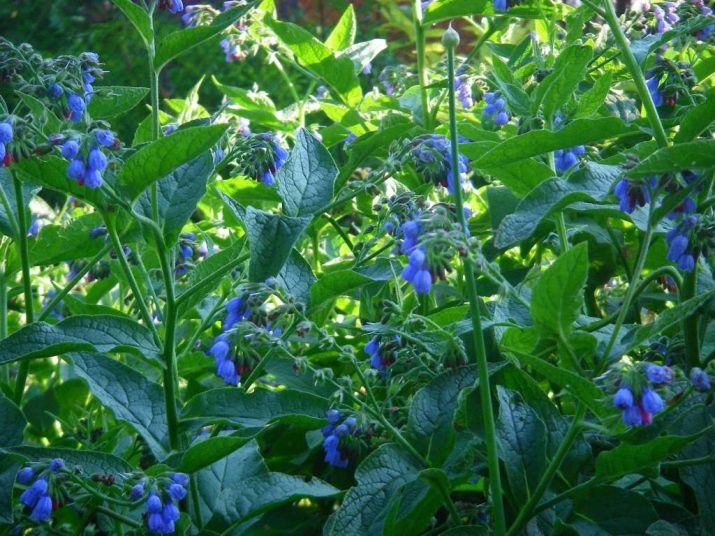Yellow leaves in tomatoes: why is this happening and how to fight?
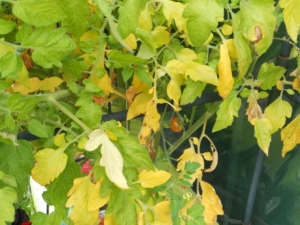
There are many signs that indicate that something is wrong with the vegetable crop.These manifestations in tomatoes include changes in the color and appearance of the leaves. They signal that the plant needs some kind of help or treatment.
The reasons
Years of experience in cultivating a vegetable such as a tomato indicate that yellowing of the foliage occurs under the wrong conditions created for the development of the plant. In addition, similar reactions in tomatoes are symptoms of various diseases.
Such situations are not uncommon - it happens that those seedlings that were quite strong yesterday, suddenly begin to wilt, the foliage becomes stained, and its tips twist and dry.
In order to effectively overcome such ailment and help the tomato recover, it is necessary to have a clear idea of the cause, which has so adversely affected the plant, and to take measures that allow tomatoes to get rid of the disease as soon as possible.
It is necessary to identify a number of the most common reasons due to which the leaves begin to turn yellow in the culture. Most often, such situations arise because of mistakes made in the process of caring for tomatoes. These include the following points:
- high acidity of the soil;
- lack of light in the place where tomatoes grow;
- overabundance or lack of moisture;
- lack of trace elements;
- supercooling of the soil or plant;
- seedlings are planted too thick;
- root damage due to tomato transplantation errors;
- improper development and operation of the plant root system;
- excess salt in the ground;
- fungal diseases.
Similar situations arise for the most part with seedlings or shortly after planting the crop in the soil. A plant like a tomato needs space, and in pots the roots twist around the earth, forming a lump. After transplantation into the open ground, the growth of young roots is activated, which pulls all the forces out of the plant. As a result, the leaves turn yellow on the tomato.
Because of a sharp cooling or frost on the ground, root feeding may be disrupted, as a result the foliage will turn yellow and then turn blue.
Having little experience of independent cultivation of vegetable crops, it is possible through carelessness in the process of loosening the soil or transplanting tomatoes to damage the roots. Some time later, the lower leaves of the seedlings turn yellow. Gradually, the plant will recover from injury and grow new adventitious leaves and roots.
Yellow leaves of tomatoes may indicate that the culture does not receive the required amount of water. In fact, tomatoes belong to a group of plants that endure drought with firmness - in an adult bush, roots can reach one meter in length, at this depth the plant also extracts moisture. With superficial and minimal watering, the water will not flow so deeply, as a result, the plant will not be able to use this liquid, and if there are no other water sources, the bush will fall ill. It is recommended to water the tomatoes infrequently, but rather abundantly.
Fusarium disease is considered to be the most common disease, as a result of which castings turn yellow in tomatoes. In addition to changing the color of the leaves, the plant becomes sluggish.
To reduce the risk of a culture disease, it is worthwhile to take preventive measures on a regular basis, if the disease has already manifested itself, it is necessary to treat the hives with antifungal drugs. Experts advise to use "Fitotsid" or "Fitosporin."
As for the lack of sunlight, such situations quite often occur in the northern regions, and with abundant watering the problems only increase. In addition, seedlings that are too thickly seeded may suffer from a lack of light, since in the process of growth one plant closes another the access to sunlight.
Yellow leaves of tomatoes will indicate a lack of trace elements. Determine what kind of fertilizer they lack, can be on the external grounds described below.
- Lack of nitrogen makes tomatoes small and pale, yellowness appears on the leaves, they become very small. Nitrogen starvation is a threat to plants during the growth of green mass, as well as during the development of fruits. Without nitrogen, tomatoes will be small and tough. Top dressing is carried out with nitrogen fertilizers, they can be prepared according to the following recipe: a spoon of urea per 10 liters of water or bird droppings - half a liter per bucket of water, adding wood ash there. In this case, a surplus of nitrogen can also harm.
- Phosphorus deficiency reduces the resistance of tomatoes to lower temperatures and diseases, in addition, this element is very important because it ensures the correct development of the root system. Its lack is indicated by the color of the leaves, their edges are bent, and the new ones grow small, tightly pressed to the stem of the plant. Phosphorus fertilizers will help solve the problem.
- Boron is a rare element.However, it is he who is responsible for the pollination and fertilization of the tomato. Its deficiency is manifested in yellowed foliage, while the upper leaves tend to brighten and then fold, the culture itself begins to bush. Feeding tomatoes can be by spraying the plant with boric acid.
- With a lack of calcium top leaves and fruits are affected, they are affected by top rot.
- An element such as magnesium is responsible for the formation of chlorophyll.which is important for the whole plant. The lack of an element is indicated by yellow leaves twisted inside. In addition, magnesium deficiency adversely affects the development of fruits. In most cases, gardeners resort to spraying the culture with magnesium nitrate to solve the problem.
- In case of insufficient feeding of tomatoes with zinc on young leaves of the plant, yellow spots are formed, and old leaves have brown or gray spots, and with time they die off.
- Yellow spots in the center of the sheet indicate a lack of iron. Feeding is carried out with a solution of ferrous sulfate.
- Potassium is responsible for the formation of ovaries and fruits in the plant. With its lack of yellow spots occur not only on the foliage, but also on the fruit. The lower leaves dry around the edges and then die off. New foliage grows shallow and thick. It is the yellow rim that indicates potassium deficiency. For processing plants on sale are various compositions containing potassium.
- With a shortage of manganese culture has the same manifestations as iron deficiency.
- Lack of sulfur first found on the bottom sheets, gradually covering the entire plant. At the same time, the development of culture is slowing down.
Similar situations with tomatoes can occur in open ground and in the greenhouse.
In the greenhouse
There are a number of main reasons on which the leaves grow sick and turn yellow in tomatoes growing in the greenhouse.
- Too tight conditions for growth. Such breeding patterns do not allow the roots of a culture to grow productively. As a result, tomato leaves will turn yellow and wither.
- Illiterate watering plants. This applies both to the lack and excess of moisture.
- Low temperature in the greenhouse. For the development of tomatoes, it is necessary that the temperature inside the room be kept within 18-22 degrees.
- Bad light. Everyone knows that sunlight provides normal photosynthesis in plants. In the darkened areas of the greenhouse, the leaves of the plant will necessarily turn yellow.
- Lack of trace elements, in particular, nitrogen. This element should be present in the soil in sufficient quantity, however, additional fertilizing of the culture with fertilizers containing nitrogen may be necessary.
- Acidized soil. It is necessary to take care of the soil condition for vegetable crops in advance. The situation can be improved by adding ash to the seedlings.
- Injury of roots during transplantation of plants or due to damage to the root system by insects.
- The development of disease. In addition to fusarium and late blight, tomatoes can be affected by the "black leg".
With timely detection of problems with planting material in the greenhouse, seedlings can be cured. In addition, the main advantage of greenhouses is the ability to control the temperature and humidity of the air for the effective development of vegetable crops in them.
In the open ground
Tomato seedlings are planted in the ground, and the basic requirement for its composition is the optimal content of trace elements that ensure the growth of tomatoes. Most of the emphasis is on the presence of copper, since the lack of this substance leads to a change in leaf color to yellow shortly after transplantation.
In contrast to the cultivation of vegetable crops in greenhouses, the leaves may turn yellow and from inappropriate weather conditions, for example, in hot weather and minimal watering on the foliage simply burns.
As a rule, the causes of yellowing are not much different from those faced by gardeners when growing tomatoes in greenhouses. But still the growth of plants in open ground has a number of specific features that can additionally provoke this process. The main ones are presented below:
- low temperatures (only an inexperienced gardener can face such a problem in greenhouses, however, tomatoes growing in the open air react to changes in temperature with yellow spots on the leaves);
- fungal diseases;
- root damage by pests;
- poor watering;
- lack of trace elements in the soil.
What to do?
In situations where preventive measures to prevent yellowing of foliage in tomatoes did not bring the expected result, it is necessary to treat the plant. To work as efficiently as possible, it is worth adhering to the algorithm of actions described below.
- The first step is to ensure that the culture has the correct irrigation system.
- During the period of illness, the plants need comprehensive support; for this, fertilizers should be used. It is best in this case to use compositions that will contain salt. These solutions are carried out daily spraying tomatoes. Work needs to be done until a new, healthy leaf grows on a tomato.
- Diseased, yellow leaves can not be recovered, so you need to focus your attention on saving the future harvest. Timely treatment measures increase the chances that the fruit will ripen and be suitable for consumption. But there may be a slight lag in development, on average for 1-2 weeks.
The recipe for the preparation of a salt spray formulation suitable for controlling late blight is as follows: half a tablespoon of salt is dissolved in five liters of water. After the element is dissolved, the plant is processed.
For the treatment of tomatoes in the greenhouse, you can also use the following drugs, which are always on sale: "Infinito", Bordeaux mixture and others.
Seedlings of tomato material will indicate the initial stage of the disease, even a slight change in color, so the plants must be monitored constantly.
To folk remedies for processing tomatoes include the composition of the leaves and roots of the comfrey pharmacist. The method of its preparation is described below.
- Infusion is prepared at the rate of 1 kg of leaves per 10 liters of water. Insist the resulting solution for at least 4 days.
- After the specified period, it is mixed with a decoction of the roots of the same plant. Instructions for brewing composition indicated on the package.
- Next, the resulting concentrate is diluted with water in a ratio of 1: 3. The solution can be watered culture or spray them. On average, about 3 meters of tomato beds consumes about one bucket of cooked money.
Prevention
It is easier to prevent the disease of culture than to carry out treatment, therefore it is necessary to carry out preventive measures with tomato seeds. This work is performed according to the following scheme:
- prepare a weakly concentrated solution of potassium permanganate: 200 ml of water per 1 gram of substance;
- then the seed is kept in it for about half an hour;
- after that, the seeds are removed and washed in running water.
Experienced gardeners also recommend disinfecting the container in which the seeds will grow, as well as processing the tools needed to care for the plants.
Greenhouse tomatoes, as a rule, are treated with the following drugs for the prevention of the disease - Pentophagus, Fitosporin-M and so on.
About why the leaves turn yellow in tomatoes, see the following video.

